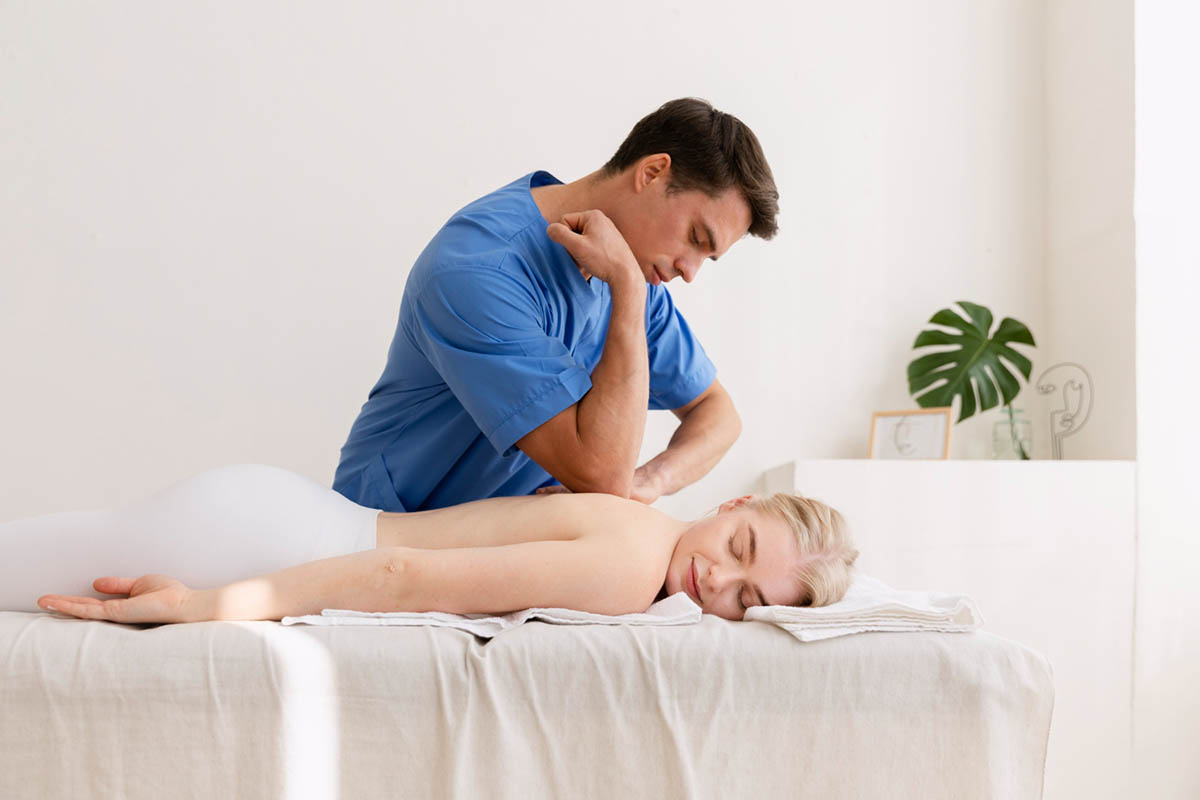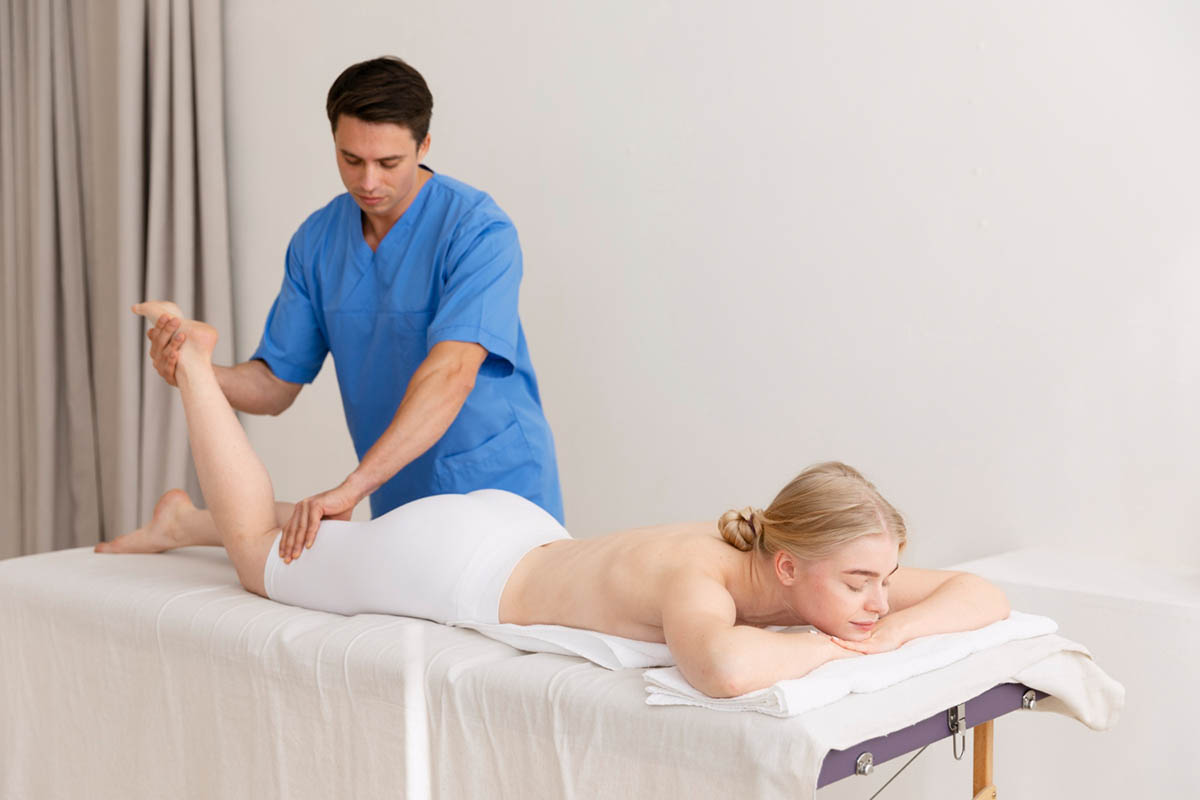Sports massage therapy is a specialized form designed to help athletic and active individuals enhance their sports performance, prevent injuries, and speed up recovery. It promotes physical benefits and the release of endorphins, which are crucial for reducing mental stress. Targeting specific soft tissues and muscles addresses the unique demands placed on the body and enhances peak performance levels. Whether you’re a professional or amateur athlete, sports massage therapy can be crucial in maintaining the body for peak performance. This article will explore sports massage therapy, its sports massage techniques, benefits, and how to choose the right certified sports massage therapists for your needs.
What Is a Sports Massage For?
Sports therapy massage is not just for athletic individuals; it’s for anyone engaged in regular physical activity, including those who experience chronic pain or muscle imbalance. Even weekend warriors can benefit from the positive effects of sports massage on common sports injuries, helping them maintain an active lifestyle. The primary goal is to improve muscle function and recovery by reducing muscular tension, promoting muscle flexibility, and alleviating discomfort caused by physical exertion. Even weekend warriors can benefit from the positive effects of sports massage on common sports injuries, helping them maintain an active lifestyle. Sports massage is exceptionally beneficial before and after intense training sessions or athletic events, as it allows the body to prepare for and recover from intense exercise.
For athletes, sports massage can address the buildup of scar tissue, reduce muscle soreness, and decrease the likelihood of future athletic injuries. It is a powerful tool for athletic trainers to use in comprehensive training programs. Sports massage has become a popular and efficient method for athletes of all skill levels to avoid injuries and reduce recovery time. For active individuals, it can improve circulation, relieve stress, and increase range of motion (ROM), making it an excellent complement to regular workouts or fitness routines.
What Does a Sports Massage Involve?
A sports massage combines various massages and common massage techniques to enhance muscle function, promote recovery, and prevent sports-related injuries. It involves manual therapies like Swedish massage, effleurage, and petrissage, improving shoulder mobility and a wide range of body flexibility. Techniques such as transverse friction massage and deep tissue massage therapy are included to address chronic muscle tension and aid in the recovery from chronic injuries.
- Swedish-Style Massage: This foundational technique features long, flowing strokes designed to enhance circulation and promote muscle relaxation. It is a key component in the broader framework of comprehensive massage therapy.
- Effleurage (Stroking): Effleurage consists of gentle, stroking movements that warm the muscle tissues and prepare them for deeper manipulation. It helps stimulate blood flow and loosen up tight muscles.
- Petrissage (Kneading): Petrissage involves deeper kneading and rolling motions designed to target deeper layers of muscle tissue. This technique can help break down adhesions and reduce muscle stiffness.
- Compression: Compression is the application of steady pressure on specific body areas to release tension and improve blood flow. This technique is excellent for loosening tight, overworked muscles.
- Friction: This method applies deeper pressure using circular or cross-fiber motions to break down scar tissue effectively. It aims to enhance flexibility in tight muscles.
- Tapotement (Rhythmic Striking): Tapotement involves tapping or striking the muscles with a cupped hand or the edge of the hand. This rhythmic technique helps stimulate the muscles and increase circulation.
- Vibration: Vibration involves quick shaking or oscillating movements that help relax muscles and stimulate the nerves. This technique also enhances circulation, promoting overall body wellness.
- Gliding: Gliding is characterized by smooth, continuous movements that help extend muscle fibers. This method is effective in improving flexibility and promoting overall muscle function.
- Stretching: Assisted stretching techniques are commonly incorporated into sports massage to improve muscle elasticity and increase joint mobility. These stretches help facilitate greater flexibility and overall performance in athletes.
- Percussion: Percussion techniques involve quick, repetitive tapping movements that promote muscle relaxation and improve blood circulation. This method effectively revitalizes tired muscles, benefiting athletes and active individuals.
- Trigger Points: Trigger point therapy focuses on releasing tight, knot-like muscle areas, often caused by repetitive movements. These knots can cause referred pain in other areas of the body, so relieving them can lead to significant pain relief.
Sports Massage Benefits

Sports massage therapy offers a range of transformative benefits beyond mere relaxation. Consistent sessions can provide both physiological and psychological impact, enhancing overall well-being. Massage therapy benefits include improved circulation, faster recovery, and relief from fatigued muscles, making it an ideal component of a wellness routine. Regular sports massage sessions can help reduce muscle fatigue, alleviate pain, and improve overall physical performance.
- Increased Joint Range of Motion (ROM): Sports massage promotes flexibility and improves joint mobility, facilitating better performance in physical activities. This therapy makes it easier for individuals to engage in their preferred sports or exercise routines.
- Increased Flexibility: Stretching and manipulating the muscles aid in lengthening them, enhancing their flexibility. This process results in more resilient and adaptable muscle fibers.
- Decreased Muscle Tension: Different massage techniques alleviate muscle tightness and diminish stiffness. This relief contributes to improved mobility and overall comfort.
- Decreased Neurological Excitability: Sports massage can help alleviate nervousness and anxiety by soothing overactive nerves. This calming effect contributes to an improved sense of relaxation and well-being.
- Decreased Muscle Spasms: Muscle spasms can occur due to repetitive stress, but sports massage therapy can effectively alleviate this discomfort. Targeting tense areas promotes relaxation and helps restore muscle function.
- Increased Sense of Well-being: Massage therapy effectively enhances mood and decreases stress, leading to a greater sense of balance and vitality. This sense of well-being contributes to overall mental and physical health improvement.
- Decreased Anxiety and Improved Mood: Consistent sports massage therapy can enhance relaxation and increase endorphin levels, improving overall mood. This combination not only alleviates stress but also fosters a sense of well-being.
- Better Sleep: Lower muscle tension and decreased stress levels can enhance sleep quality, facilitating better recovery. This ultimately promotes overall physical and mental health.
Limits of Sports Massage
Despite its numerous benefits, sports massage does have some limitations. While it can improve muscle function, aid in recovery from exercise, and release metabolic waste products, it’s not a guaranteed method to enhance athletic performance. It is, however, an effective treatment for maintaining optimal performance and managing common injuries. A sports massage represents an effective tool frequently used in sports for recovery and preparation, with evidence showing it is involved in 45% more medical treatments at major sports events than other methods. However, sports massage should be seen as a recovery process tool rather than a performance enhancer. A meta-analysis published in the British Journal of Sports Medicine, which examined 29 studies, found that sports massage does not improve sprinting, jumping, strength, endurance, or fatigue. Therefore, sports massage should be seen more as a recovery and injury prevention tool than a performance enhancer.
Additionally, it’s essential to recognize that sports massage cannot replace proper training, conditioning, or medical treatment for injuries. It is a complementary therapy that is best used in conjunction with other recovery and conditioning strategies.
Difference Between Deep Tissue Massage and Sports Massage
While deep tissue techniques and sports massage share similarities, their comprehensive approach and goals differ. Deep tissue massage primarily focuses on chronic conditions, while sports massage is designed to help with faster recovery and improving training programs for athletes. It’s often used for individuals with painful conditions like back pain or muscle tightness due to poor posture.
On the other hand, sports massage is more dynamic and tailored to the specific needs of athletic or active individuals. It aims to improve mobility, enhance muscle recovery, and prevent injuries through stretching, kneading, and trigger point therapy.
Finding a Sports Massage Therapist
When looking for a licensed massage therapist, finding someone with experience and proper qualifications is essential. If you’re searching for sports massage therapy near me, choose a therapist with a strong background in working with athletes. A therapist with a certificate program in sports massage and adequate flexibility in handling individual athletes and their health conditions is essential. You may also find therapists combining chiropractic care or electrical stimulation with massage therapy in clinical settings.
If you’re in Spartanburg, SC, Progressive Mobility Physio & Performance offers a range of massage therapy techniques specifically designed for athletes and active individuals. These services ensure you receive the highest care for your body’s needs.
Choosing the Right Service

When deciding on a sports massage service, consider the type of physical activity you engage in, your fitness goals, and any existing injuries or conditions. Whether you need maintenance, post-event, or even an ice massage, your therapist can help you tailor the session for optimal performance. For example, if you’re recovering from an acute injury, you may want a session that focuses on rehabilitation. A pre-event massage designed to enhance flexibility and blood flow might be more suitable if you’re preparing for an event. Always communicate your needs and concerns with your therapist so they can tailor the session to meet your specific goals.
Conclusion
Sports massage therapy is an invaluable resource for athletes and physically active individuals aiming to optimize their recovery and minimize the risk of injury. Utilizing dynamic techniques, it targets the entire body by focusing on muscle groups such as the forearms while contributing to training objectives. Consistent sessions are vital for managing long-term health, allowing individuals to reap the full benefits. Techniques such as stretching, myofascial release, kneading, and percussion work synergistically to enhance muscle balance, alleviate fatigue, and support overall well-being. Nonetheless, it is important to recognize its limitations; sports massage should complement other performance strategies rather than be the sole approach for enhancement.
FAQs
What should I expect during a sports massage session?
A typical sports massage session involves deep tissue work, stretching, and pressure applied to specific muscle groups. The therapist may also focus on trigger points and use techniques like effleurage or petrissage to address muscle tension.
How often should I get a sports massage?
It depends on your activity level. Athletes in training may benefit from weekly or bi-weekly sessions, while less active individuals might schedule massages once a month.
Are there any risks associated with sports massage?
While generally safe, some risks include muscle soreness or bruising, mainly if too much pressure is applied. Always communicate with your therapist to ensure a comfortable experience.



